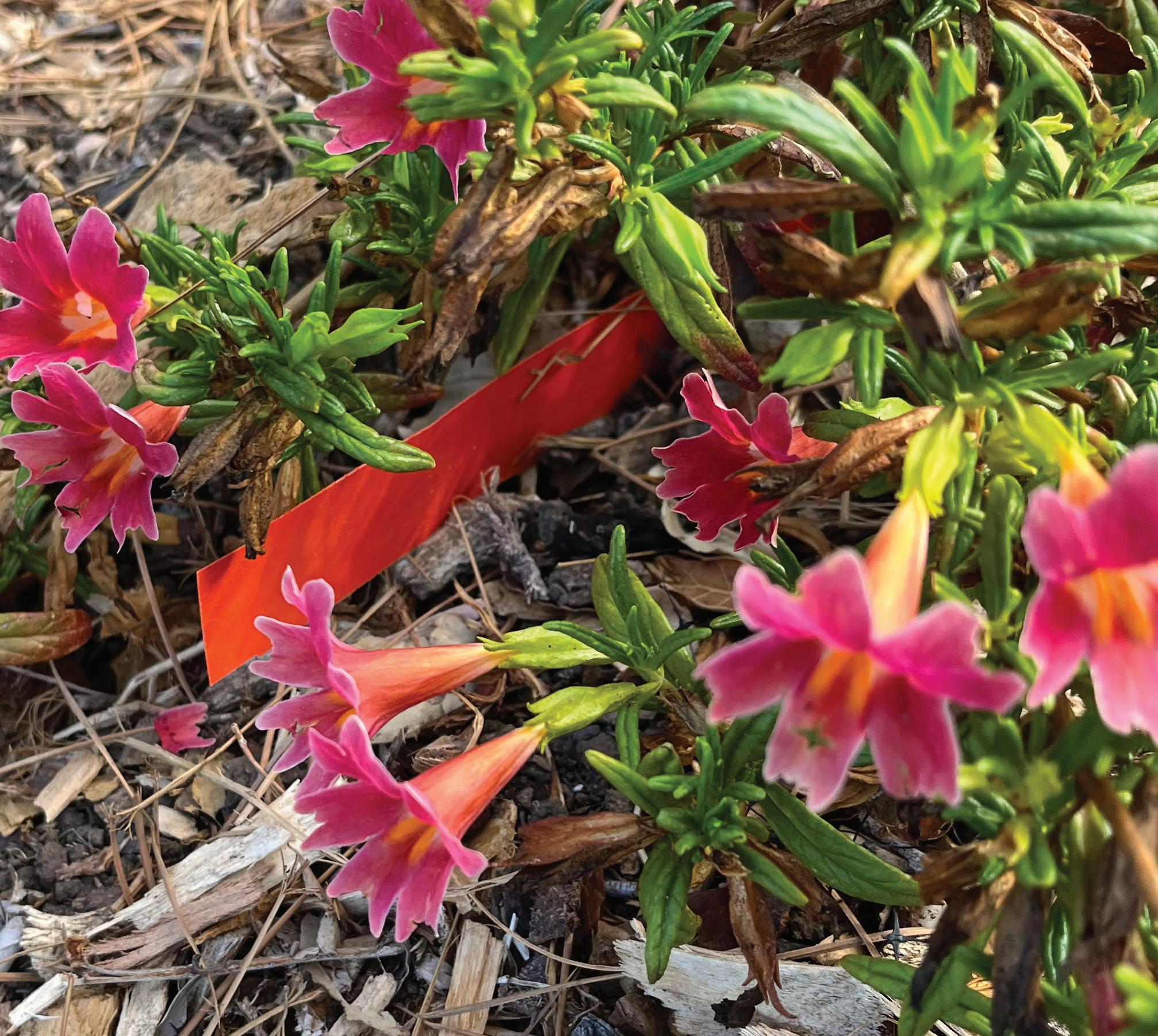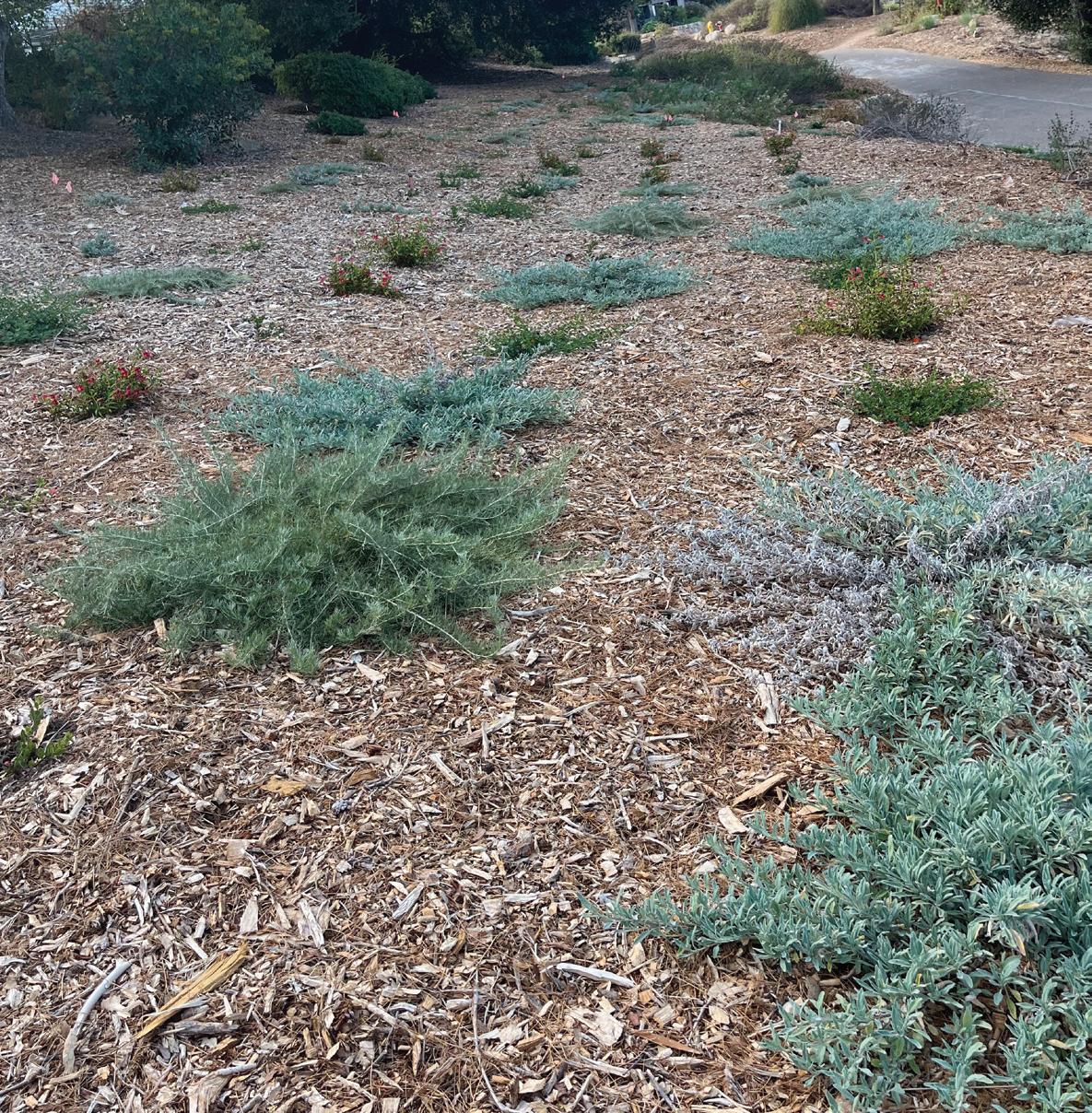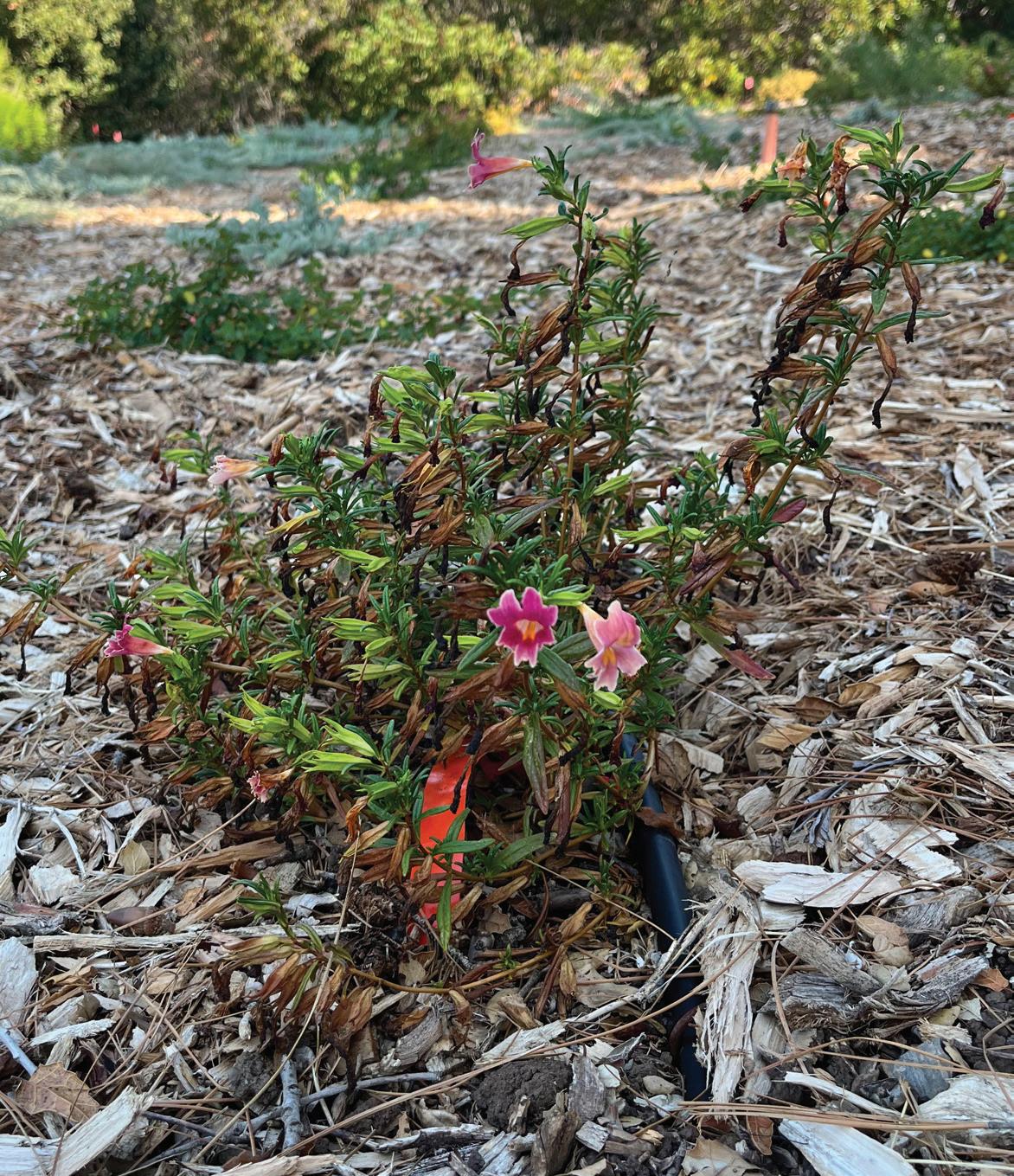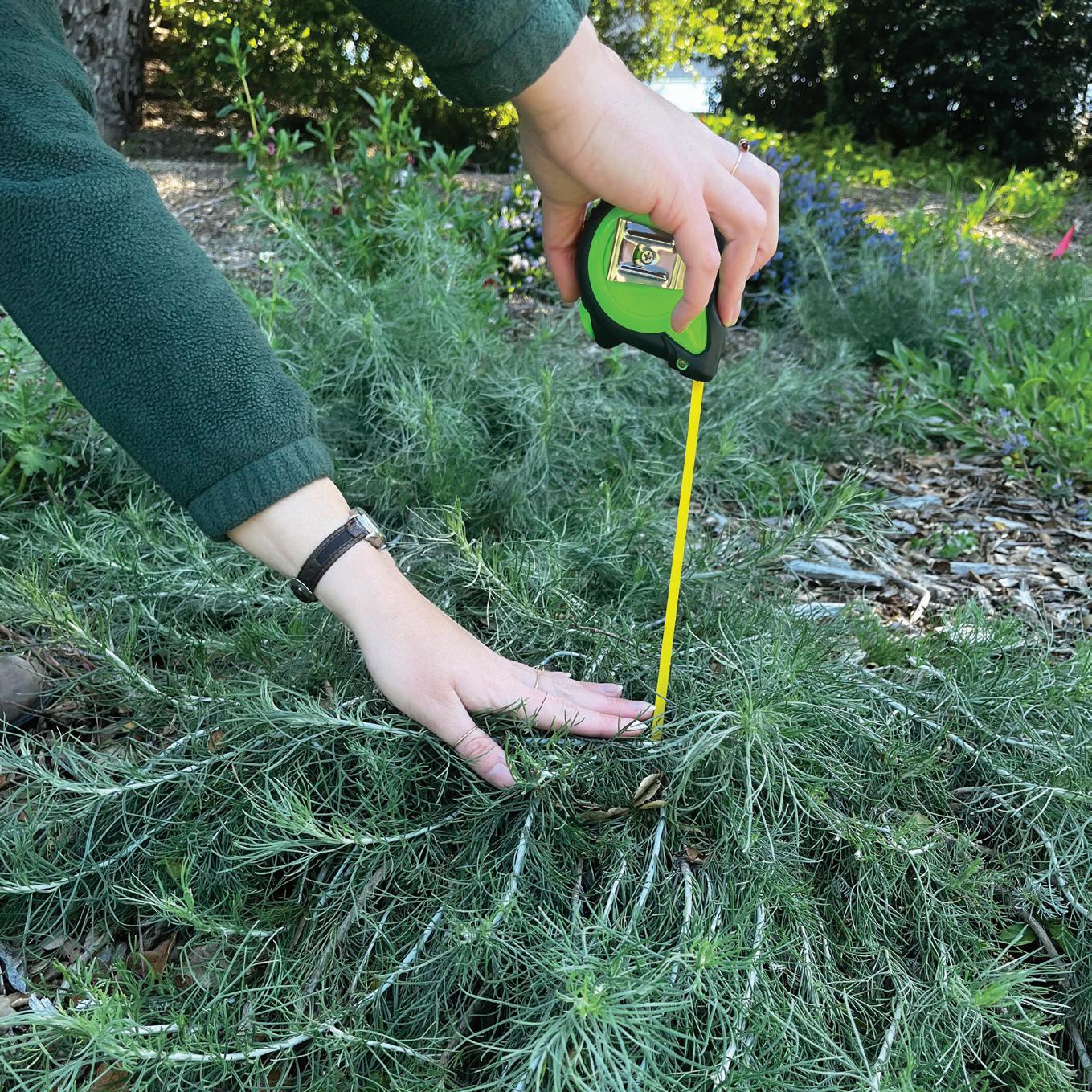
8 minute read
The Truth About Growing Native Plants — Climate, Conditions, and Brats
By Christina Varnava, Living Collections Curator
Typical gardening wisdom is built around the ubiquitous garden-center species. These commonly sold plants hail from all different parts of the world, and the care that works for them is not necessarily what will work for California’s native species.
California’s unique Mediterranean climate is found in only a handful of places on Earth. This climate brings an unusual rainfall pattern where plants are accustomed to hot, dry summers that give way to cool, wet winters. This means, native plants are adapted to experiencing drought every year. However, many commonly cultivated, widely available garden plants are adapted to very different rainfall patterns. In turn, they have very different horticultural needs and considerations that people have adopted as the norm in gardening.
The abundance and divergent requirements of these nonnative plants at garden centers and nurseries leads home gardeners and landscape professionals astray. Subsequently the successful cultivation and establishment of California’s native plants seems mysterious, and they have a reputation as being difficult to care for. Which is frustrating for would-be gardeners because out in the wild they seem to, you know, just grow.
Digging Into Assumptions and Considerations
For an aspiring native-plant newbie in California, it may seem like there are very few answers to seemingly basic questions. For starters, there’s the eternal question of how much water should gardeners use to help establish California’s native plants? It’s a difficult question to answer because a plant’s water usage is dependent on many factors: weather conditions, soil type, and the species of plant. Additionally, the period of establishment is another important query, as the plant adapts to its new soil and microclimate. Then, is the “correct” size of plant to install in the ground a factor? Is buying a larger-sized plant better for rapid growth and healthy plants?
Many growers with experience of the common chaparral-adapted species have recommended that California’s natives should be planted at a smaller size. In the nursery trade, it is generally believed smaller plants are a lot more drought tolerant and resilient once they are established than those that were originally planted at a larger size. The idea behind this is that large plants grow up accustomed to the regular watering and softer soils in nurseries and are less able to adjust to in-ground conditions (less water, heavy clay soils). These plants are sometimes called “nursery brats,” because they are so used to pampering and optimal conditions that they cannot adjust very well to heat and drought. Further compounding this issue is that very little research has been done to investigate these ideas.

The Perimeters of our Research Parameters
Horticultural research is important to determine the best ways to cultivate California’s native plants, and to start investigating some of the myths that have sprung up around these plants. We created a test plot at Santa Barbara Botanic Garden with a grant from the Stanley Smith Horticultural Trust to help gardeners and growers understand how different horticultural practices can affect the establishment of these plants. Our establishment trial were used to plant commonly available and desirable cultivars of five different native chaparral-adapted species, with two different pot sizes and three different watering regimes.
The following are the five cultivars used for our trial.
• Little Sur manzanita (Arctostaphylos edmundsii ‘Little Sur’)
• Yankee Point Carmel ceanothus (Ceanothus hyrsiflorus var. griseus ‘Yankee Point’)
• Bee’s Bliss sage (Salvia ‘Bee’s Bliss’)
• Canyon Gray sagebrush (Artemisia californica ‘Canyon Gray’)
• Jelly Bean Dark Pink monkeyflower (Diplacus Jelly Bean™ ‘Dark Pink’)

We chose species that spanned a good deal of taxonomic diversity to test if the nursery brat idea might apply more to one group of plants than another. Plants were grown with staggered starts to ensure that all the plants were grown to the same degree. Half of the plants in each treatment were originally planted from 4-inch pots and half were planted from 1-gallon pots.
We planted these across three different treatment plots, randomly assigned sloping north to south. After plants were installed, the slope was mulched with 1 foot (.3 meters) of organic mulch and weeded periodically. Plots were watered using drip irrigation with 1-gallon-per-hour emitters, with high, medium, and low irrigation levels. These irrigation levels were based on the landscape watering calculator at WaterwiseSB.org, the Regional Water Efficiency Program of Santa Barbara County. This calculator is designed for home landscapers and seemed to be a good approximation of where the average home gardener might begin with determining an appropriate watering regime. Along with supplemental water from the drip irrigation, we recorded monthly rainfall totals using the weather station at the Garden. Immediately after installation, and once each month for two years, the growth for each plant was measured. In 2024, the last measurements were taken.

The Winner Is?
There is no one-size-fits-all research project, and there are still a lot of questions to explore, as this study was by no means definitive. But let’s highlight a few tips based on what we noticed and then get into the specifics:
• Consider the environmental conditions where these native species are growing in wild habitats and incorporate that into your home garden.
This may net you more success than following general planting rules.
• Plants that received more water did grow much larger, but then they experienced a lot more dieback when the dry summertime conditions set in. Those seeking to cultivate chaparral-adapted native plants may be wise to water less and expect slightly slower but more reliable growth rates.
• There did not appear to be any effect from initial pot size on the growth of the plants in the trial, so the myth of the nursery brat began to unravel.

Let’s examine these points further. It was difficult to draw solid conclusions in this study due to a few confounding factors. First, by complete coincidence the study was conducted in 2022 and 2023, two of the highest rainfall years Southern California has experienced in decades. The rainy season for these years was also a lot longer than a typical one, with rain persisting into May and June in both those years. It would be beneficial to repeat this type of study in a year with more typical levels of rainfall.

Also, results varied between the different plant species used in our trial so looking at the outcomes of individual species is perhaps most useful. Growth was significantly different between all plant species in the project with some (e.g., Canyon Gray sagebrush and Bee’s Bliss sage) growing very large and fluctuating in size as the season changed (figure 1). These species were observed to grow very large in the spring, and then began to die back a lot as summer drought conditions set in. This effect was most noticeable in the plot that received the highest irrigation. By comparison, Little Sur manzanita and Yankee Point Carmel ceanothus had much lower overall growth rates but did not suffer as much branch dieback in the summer. The Jelly Bean Dark Pink monkeyflower was the species that experienced the highest mortality rates in our study, which was seen across both 4-inch and 1-gallon plants but occurred mostly in the lowest water treatment plot.

Nursery Brats Concept Likely Not Real
Perhaps most sweepingly, we concluded that the nursery brat is not a real phenomenon. The 4-inch and 1-gallon plants grew about the same amount, no matter how much supplemental irrigation they received. There seemed to have been an irrigation effect early in the study, but by the end of the trial these differences had flattened out. So, for example, instead of seeing a greater impact on the 1-gallon plants that were in the low-water treatment plot, we saw no difference. The growth results and the mortality rates indicated as such. And by the end of the study, all the plant cultivars used in the trial, except Little Sur manzanita, showed no statistically significant differences between a plant that began as a 4-inch or a 1-gallon. The manzanitas were, in fact, healthier and larger when planted as a 1-gallon.
There’s still so much to learn! The Garden’s work to understand the factors that lead to happy, healthy plants will continue on, so we can continue to support our mission of getting more native plants into California yards and landscapes.










